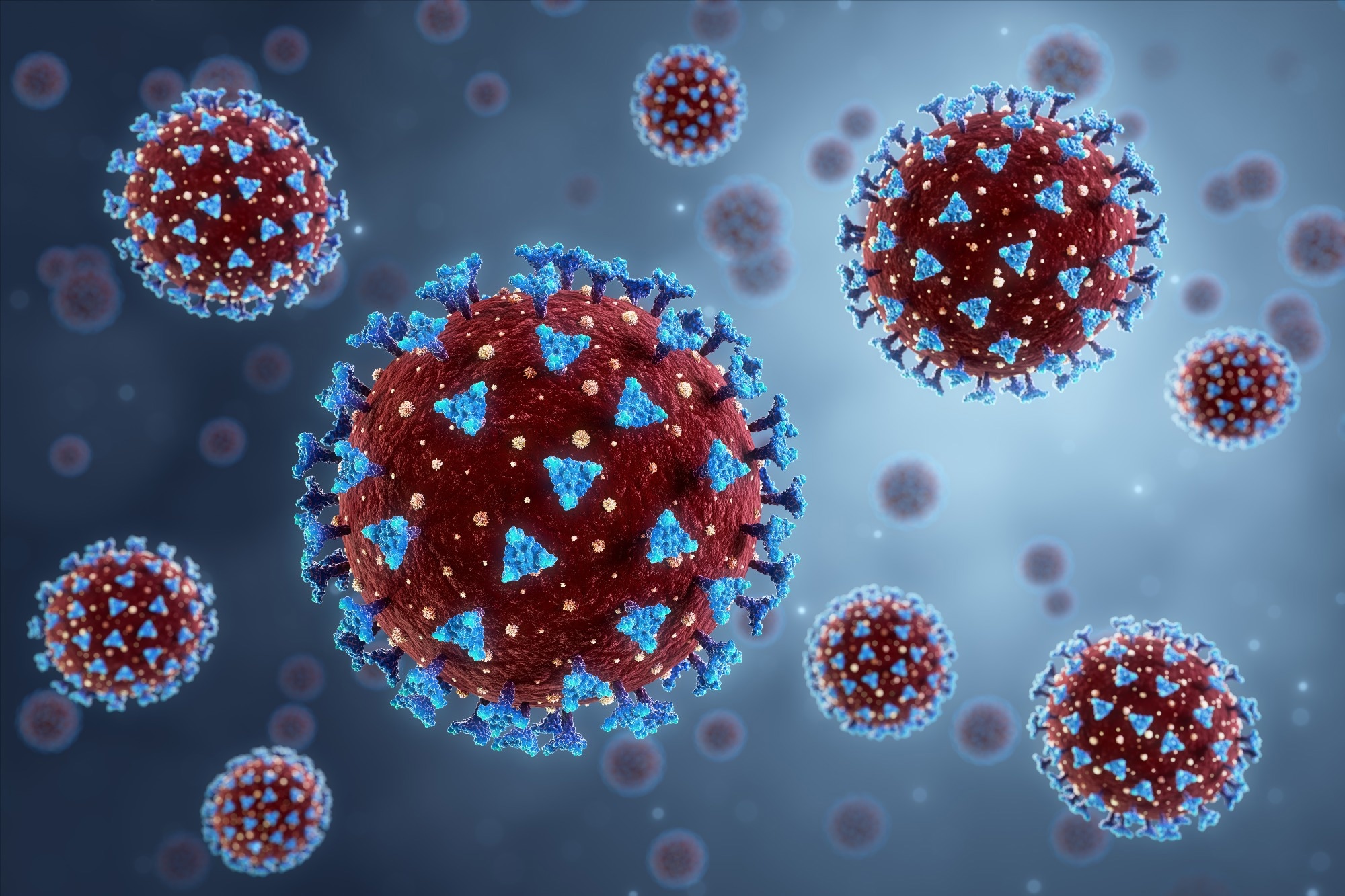In a recent article posted to the bioRxiv* server, researchers performed an experimental assessment of the antigenicity and infectivity of BA.2.86, a newly emerged severe acute respiratory syndrome coronavirus 2 (SARS-CoV-2) saltation variant designated as a variant under monitoring (VUM) by the World Health Organization (WHO) on August 18, 2023.
 Study: Antigenicity and infectivity characterization of SARS-CoV-2 BA.2.86. Image Credit: JBArt / Shutterstock
Study: Antigenicity and infectivity characterization of SARS-CoV-2 BA.2.86. Image Credit: JBArt / Shutterstock

 *Important notice: bioRxiv publishes preliminary scientific reports that are not peer-reviewed and, therefore, should not be regarded as conclusive, guide clinical practice/health-related behavior, or treated as established information.
*Important notice: bioRxiv publishes preliminary scientific reports that are not peer-reviewed and, therefore, should not be regarded as conclusive, guide clinical practice/health-related behavior, or treated as established information.
Background
So far, researchers have detected only 24 genomic sequences of BA.2.86; however, notably, they originated in individuals in multiple countries with no travel history. While BA.2.86 sequences might not be of any epidemiological relevance, this variant exhibits the potential for global spread. Furthermore, BA.2.86 harbors many more mutations than its predecessors, BA.2 and XBB.1.5, suggesting its distinct antigenicity.
Mutations that mediate its enhanced resistance to convalescent plasma from XBB breakthrough infection (BTI) and reinfections are nested inside the receptor-binding domain (RBD) of its spike (S) glycoprotein. In addition, mutations in BA.2.86's N-terminal domain (NTD) and sub-domain 1 (SD1) contribute to its enhanced resistance.
It seems like BA.2.86 has traded off its infectivity for acquiring higher immune evading capabilities during evolution, which calls for close monitoring.
About the study
In the present study, researchers first developed a BA.2.86 pseudovirus and then determined its antigenic distance from wildtype (WT) and other preceding SARS-CoV-2 variants, including Omicron sublineages, BA.5, BQ.1.1, and XBB.
Further, they evaluated the immunity-evading capabilities of BA.2.86 pseudovirus. To this end, they performed pseudovirus neutralization assays using plasma samples from two groups and against a monoclonal antibodies (mAbs) panel.
The first group comprised 27 individuals who experienced XBB BTI only once after vaccination, and the second group had 54 convalescents who contracted XBB (re)infection after BTI from BA.5/BF.7. All participants had received three doses of an inactivated coronavirus disease 2019 (COVID-19) vaccine before XBB BTI.
Furthermore, the team delineated the key RBD mutations of BA.2.86 from that found in XBB.1.5, for which they tested a panel of neutralizing antibodies (nAbs) against XBB.1.5-based pseudoviruses carrying one BA.2.86 RBD mutation. Finally, the team evaluated the cellular infectivity of BA.2.86 by testing the efficacy of its pseudovirus form in infecting hACE2-HEK293T cell lines.
Results
BA.2.86 showed a pronounced antigenic drift from WT, BA.2/BA.5, and XBB.1.5 SARS-CoV-2 variants, suggesting it could strongly evade XBB-induced antibodies. It also exhibited exceptionally high resistance in neutralization assays across all vaccinated groups.
Interestingly, BA.2.86's immune evading potential exceeded EG.5 but was comparable to Omicron's "FLip" variant HK.3, a double mutant with L455F & F456L combination mutations. Despite their comparable level of immune evasion, the relative activities of HK.3 and BA.2.86 varied across samples, indicating their antigenic distance. Further, BA.2.86 induced markedly higher antibody evasion against XBB-stimulated plasma. Except for SA55, other mAbs tested in this study failed to neutralize BA.2.86.
Importantly, the E554K mutation in combination with XBB.1.5 mutations enhanced plasma evasion of BA.2.86, suggesting that SD1- targeting nAbs majorly constitute XBB-stimulated convalescent plasma. Furthermore, BA.2.86's NTD mutations enhanced its neutralizing evasion.
In pseudovirus assays, relative to XBB.1.5 and EG.5.1/EG.5, BA.2.86 exhibited the lowest infectivity. The authors noted that K356T, V483del, and E554K mutations mainly contributed to its lower infectivity. Specifically, K356T introduced an N-linked glycosylation motif for amino acid site N354, and V483del was close to angiotensin-converting enzyme 2 (ACE2)-binding sites, with both events affecting viruses' host cell entry efficacy.
The researchers measured BA.2.86 infectivity through pseudovirus assays; thus, these results require further validation using authentic isolates.
Conclusion
The study data suggested that BA.2.86 exhibited exceptional immunity-evading potential compared to currently circulating SARS-CoV-2 Omicron variants. Furthermore, BA.2.86 was antigenically farther from all Omicron variants tested and could escape XBB-induced nAbs, i.e., resist XBB-elicited humoral immunity and XBB-effective mAbs.
Even though, at present, it seems that BA.2.86 might not prevail due to its lower infectiousness. However, if it further mutates during host-viral evolution and transmission, it might enhance its infectivity. Given its potential to become a predominant SARS-CoV-2 variant shortly, like Omicron's XBB subvariants, global cooperation would be necessary to chart the BA.2.86 evolution over time.

 *Important notice: bioRxiv publishes preliminary scientific reports that are not peer-reviewed and, therefore, should not be regarded as conclusive, guide clinical practice/health-related behavior, or treated as established information.
*Important notice: bioRxiv publishes preliminary scientific reports that are not peer-reviewed and, therefore, should not be regarded as conclusive, guide clinical practice/health-related behavior, or treated as established information.
Journal reference:
- Preliminary scientific report.
Antigenicity and infectivity characterization of SARS-CoV-2 BA.2.86, Sijie Yang, Yuanling Yu, Fanchong Jian, Weiliang Song, Ayijiang Yisimayi, Xiaosu Chen, Yanli Xu, Peng Wang, Lingling Yu, Jing Wang, Xiao Niu, Jing Wang, Tianhe Xiao, Ran An, Yao Wang, Qingqing Gu, Fei Shao, Ronghua Jin, Zhongyang Shen, Youchun Wang, Yunlong Richard Cao, bioRxiv 2023.09.01.555815; doi: https://doi.org/10.1101/2023.09.01.555815, https://www.biorxiv.org/content/10.1101/2023.09.01.555815v1